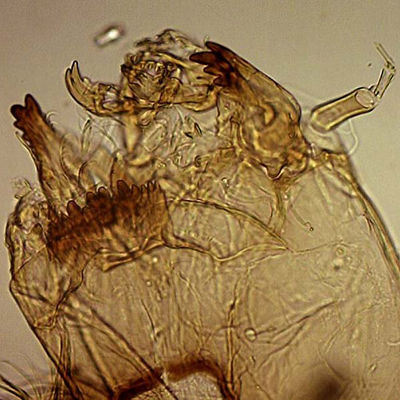Midges have a notable reputation among biologists. Like that one difficult family member you dodge at gatherings, many biologists (myself included) do not look forward to encounters with midges. However, aquatic Bioassessment programs must make this choice – leave midges at the family level, i.e. Chironomidae, or identify them to the genus and species level. It is the latter that gives midges a reputation as being “too difficult and time consuming”. The source of their apparent notoriety is due to a few things. First of all, Chironomid midges are small. Mature larvae range in size from about 2 to 30 mm, and many of the characters used for identification such as antennae and structures of their mouthparts are minute. Because their features are extremely small, it is best to examine specimens with a compound microscope. This leads to the next source of difficulty - mounting the midge on a microscope slide. While placing a midge on a slide doesn’t sound daunting, it can quickly prove otherwise. The specimen must be positioned in a specific way to allow clear visibility of those previously mentioned minute characters.
Dealing with midges simply takes time and practice. Despite these challenges, Chironomid midges have great value in aquatic bioassessment. Midges are an important part of aquatic food webs and are often the most diverse and abundant group of macroinvertebrates encountered during monitoring. There are 369 different taxa listed under Chironomidae on the Ohio EPA Macroinvertebrate Taxa List – if we stopped at Chironomidae it would be only 1. By comparison, the same list has 322 Mayflies, Caddisflies, and Stoneflies combined. In addition, they inhabit nearly every aquatic habitat and reveal a wide range of water quality. By taking the time and effort to identify midges to the lowest taxonomic resolution possible, the reward is a much better assessment of a river or stream. This reward is obtained by revealing their rich taxonomic diversity which reveals equally rich information about a river or stream. Processing to the genus/species level allows midges to function as better indicators of water quality.
A diverse mix of responses to common aquatic stressors is the reward for the effort taken to process midges beyond the family level – it leads to better biological monitoring. So what’s a biologist to do? How can one face and overcome the fear of midges? The task seems similar to a weekend hiker deciding to travel the entire Appalachian Trail – and it’s obvious that proper training and good planning are necessary. The following is the approach that is proving effective for me ....so far. Start Small There are often huge numbers of midges collected from large streams and rivers so it seems best to start the learning process from samples collected at smaller from smaller streams. The diversity and abundances of midges are much more manageable within these samples and easier to build upon. Start Big Mounting midges onto slides is truly a challenging task. One must be meticulous to successfully position several midges in the proper way under the same cover slip. It has proven much easier to learn how to handle and position larger specimens and then progressively move to smaller ones. Find a Good Teacher In order to identify midges to the genus and species levels, it seems imperative to have an experienced taxonomist initially verify the structures listed in the keys. It is often confusing to locate characters for the first time especially because the midge may be smaller or not mounted as well as the key’s illustrations. Like any technical task, an apprenticeship period is required. Lie to Yourself Okay, lie may be a strong word. But in the same way dieters tell themselves the low-fat brownie tastes just as good, there is an assertion frequently repeated among the veterans in the lab “Midges are fun!”. There is power in positive thinking so okay - I’ll concede, “Midges are………..fun”. Get Organized As is true when learning most new things, it is important to have your materials organized and record new discoveries as you encounter new things.
There are several keys necessary to use as references and within the various keys sometimes different terminology is used for the same features so it’s important to stay organized and build on previous discoveries. When faced with any new challenge, however unpleasant, there are usually lessons to be learned, knowledge to be gained, and character to be built. With the experience gained from facing my fear of midges, who knows what challenge may be accomplished next? Realize the Reward In Ohio, midges are an essential component of the methods by which rivers and streams are assessed because they are key indicators for determining stream and river quality. This makes identifying midges “worth the effort”.

